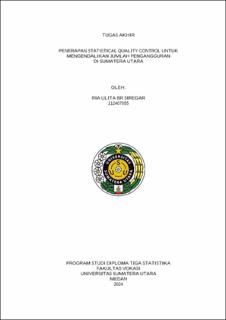Penerapan Statistical Quality Control untuk Mengendalikan Jumlah Pengangguran di Sumatera Utara
The Implementation of Statistical Quality Control to Control The Number of Unemployed in Sumatera Utara

Date
2024Author
Siregar, Ria Ulita Br
Advisor(s)
Hasibuan, Citra Dewi
Metadata
Show full item recordAbstract
Unemployment is one of the complex and persistent social and economic issues
faced by both developing and developed countries. This research aims to apply
the Statistical Quality Control (SQC) method to control the number of
unemployed individuals in Sumatera Utara. SQC is a method that uses statistical
techniques to monitor and control processes to ensure that the quality of products
or outcomes remains within specified limits. The study utilizes secondary data
obtained from the Badan Pusat Statistika (BPS), which includes data on the
number of unemployed individuals in Sumatera Utara from 2017-2021. This data
is categorized based on the highest level of education completed. Using variable
control charts (X̅ -chart and R-chart), the central line value for the X̅ chart was
found to be 12961,9030 with an Upper Control Limit (UCL) of 16046,5770 and a
Lower Control Limit (LCL) of 9887,2290. For the R chart, the central line value
was 5347,9091 with a UCL of 11308,1537 and an LCL of 0. The results from the
study indicate that the final outcomes for both the X̅ and R control charts are still
in an uncontrolled condition, as evidenced by several points that lie outside the
control limits (out of control). Meanwhile, for the attribute control chart (PChart),
the central line value was found to be 0.0597 with a UCL of 0.0609 and
an LCL of 0.0585. The results from this research show that the final outcome for
the P control chart is also in an uncontrolled condition because all points lie
outside the control limits (out of control). Therefore, continuous improvements
are necessary to reduce the defect rate in the number of unemployed individuals.
Collections
- Diploma Papers [191]
